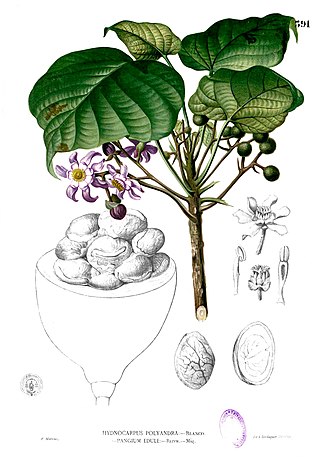
Meliaceae, the mahogany family, is a flowering plant family of mostly trees and shrubs in the order Sapindales.

Acanthaceae is a family of dicotyledonous flowering plants containing almost 250 genera and about 2500 species. Most are tropical herbs, shrubs, or twining vines; some are epiphytes. Only a few species are distributed in temperate regions. The four main centres of distribution are Indonesia and Malaysia, Africa, Brazil, and Central America. Representatives of the family can be found in nearly every habitat, including dense or open forests, scrublands, wet fields and valleys, sea coast and marine areas, swamps, and mangrove forests.

The Sapotaceae are a family of flowering plants belonging to the order Ericales. The family includes about 800 species of evergreen trees and shrubs in around 65 genera. Their distribution is pantropical.

Guibourtia is a flowering plant genus in the family Fabaceae, also known by the common names as Rhodesian copalwood, African Rosewood, amazique, bubinga, kevazingo, and ovangkol.
Phelline is a genus of shrubs and the sole member of the family Phellinaceae, a family of flowering plants endemic to New Caledonia. It is placed in the order Asterales and is related to two other small plant families: Alseuosmiaceae and Argophyllaceae. It contains ten species.

Achariaceae is a family of flowering plants consisting of 31 genera and about 155 species of tropical herbs, shrubs, and trees. The APG IV system has greatly expanded the scope of the family by including many genera previously classified in Flacourtiaceae. Molecular data strongly support the inclusion of this family in the order Malpighiales.

Argomuellera is a genus of plant of the family Euphorbiaceae first described as a genus in 1894. It is native to sub-Saharan Africa, Madagascar, and the Comoros Islands.

Schefflera is a genus of flowering plants in the family Araliaceae with 13 species native to New Zealand and some Pacific islands.

Dysoxylum is a genus of rainforest trees and shrubs in the flowering plant family Meliaceae. About 34 species are recognised in the genus, distributed from India and southern China, through southeast Asia to New Guinea, Solomon Islands, and Australia. The name Dysoxylum derives from the Greek word ‘Dys’ meaning "bad" referring to "ill-smelling" and ‘Xylon’ meaning "wood".

Cynometra is genus of tropical forest trees with a pantropical distribution.

The subfamily Detarioideae is one of the subdivisions of the plant family Fabaceae (legumes). This subfamily includes many tropical trees, some of which are used for timber or have ecological importance. The subfamily consists of 84 genera, most of which are native to Africa and Asia. Pride of Burma and tamarind are two of the most notable species in Detarioideae. It has the following clade-based definition:
The most inclusive crown clade containing Goniorrhachis marginataTaub. and Aphanocalyx cynometroidesOliv., but not Cercis canadensisL., Duparquetia orchidaceaBaill., or Bobgunnia fistuloides(Harms) J. H. Kirkbr. & Wiersema.

Alangium is a small genus of flowering plants. The genus is included either in a broad view of the dogwood family Cornaceae, or as the sole member of its own family Alangiaceae. Alangium has about 40 species, but some of the species boundaries are not entirely clear. The type species for Alangium is Alangium decapetalum, which is now treated as a subspecies of Alangium salviifolium. All of the species are shrubs or small trees, except the liana Alangium kwangsiense. A. chinense, A. platanifolium, and A. salviifolium are known in cultivation.

Anthonotha is a genus within the subfamily Detarioideae of the plant family Fabaceae.
Englerodendron is a small genus of legumes belonging to the family Fabaceae, that are native to tropical Africa.

Gilbertiodendron is a genus of legume in the family Fabaceae. It consists of about 25 species of tree native to west and west-central tropical Africa. Members of this genus were formerly considered to be in the genus Macrolobium but that genus is now restricted to species growing in tropical America. It is closely related to Pellegriniodendron.

Dypsis is a genus of flowering plants in the family Arecaceae. They are slender, evergreen palms with yellow flowers carried in panicles amongst the pinnate leaves. Many Dypsis species have aerial branching, a rare growth habit among palms. Some have marcescent leaves that remain attached after death and trap litter for nutrients. Several species previously placed here have been returned to the restored genera Chrysalidocarpus and Vonitra.

Newtonia is a genus of flowering plants in the legume family, Fabaceae. It includes 16 species of trees native to sub-Saharan Africa. It belongs to subfamily Caesalpinioideae and the Mimosoid clade or tribe. The genus is known from the early Miocene of Ethiopia based on compressions of its diagnostic, winged seeds.
Spirotecoma is a genus of plants in the family Bignoniaceae.

Prioria is a genus of flowering plants in the family Fabaceae. Members of this genus are found in Central America, Africa, southern Asia, and Oceania.















